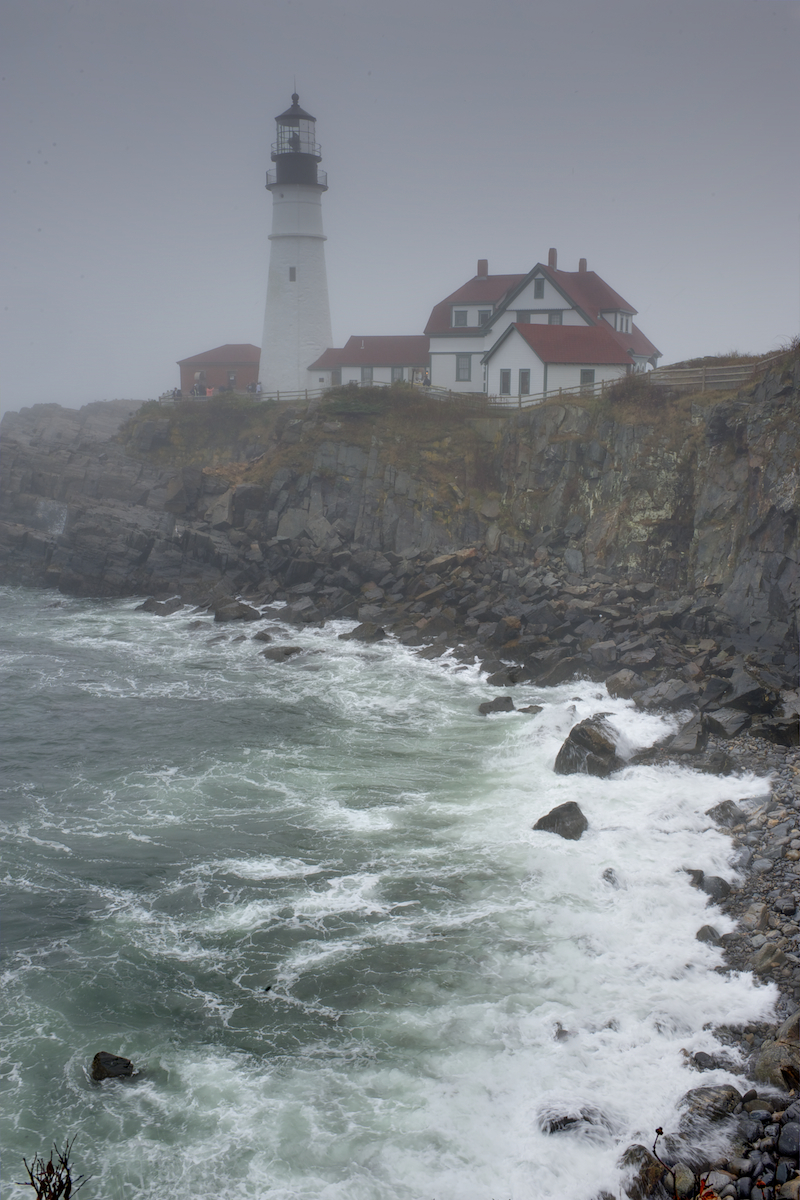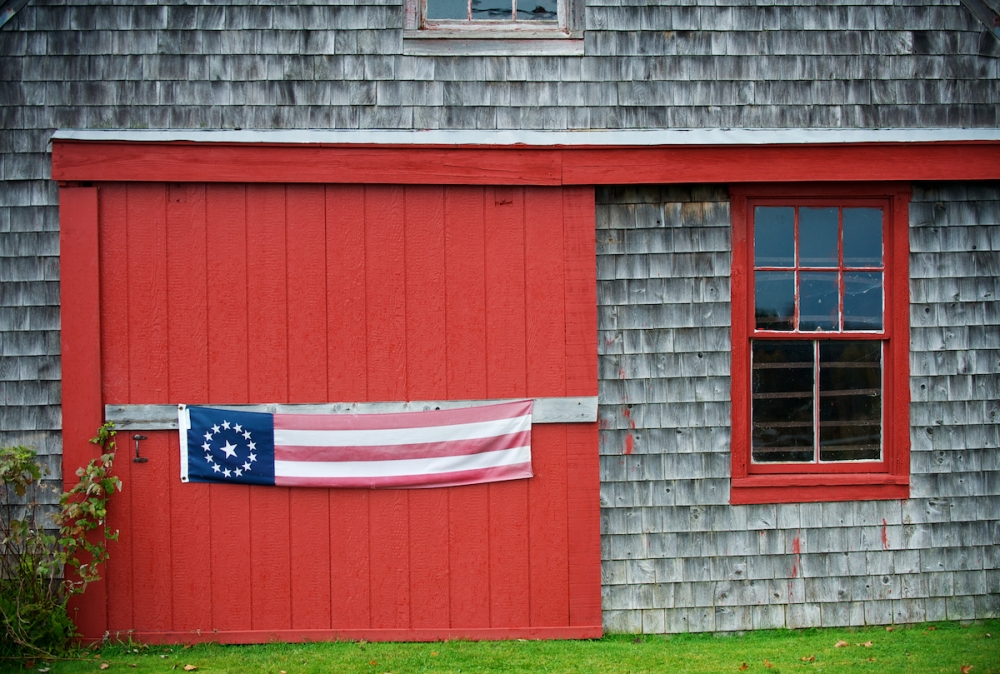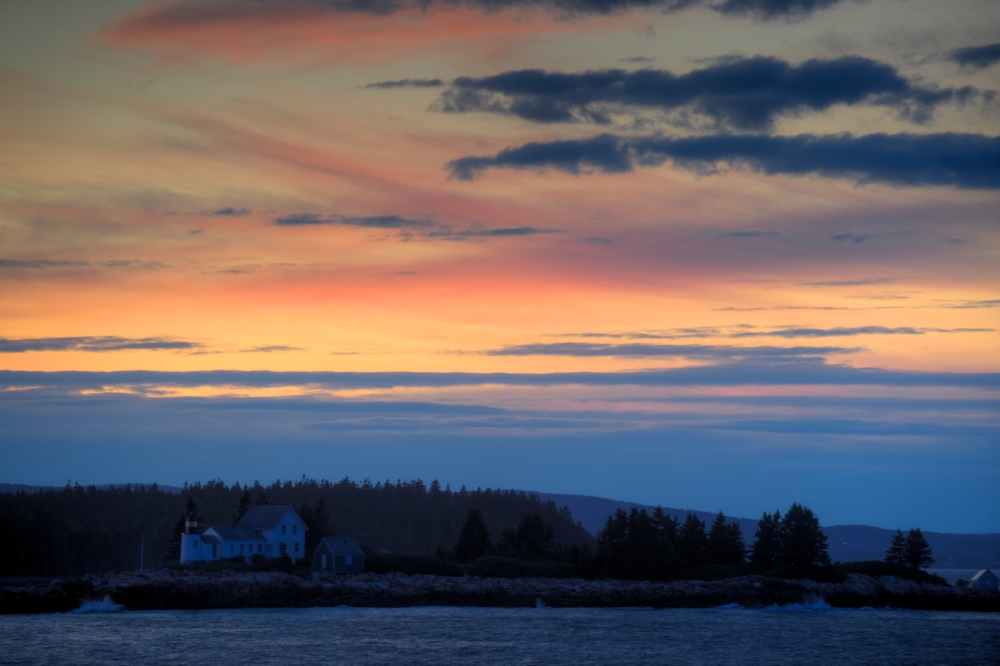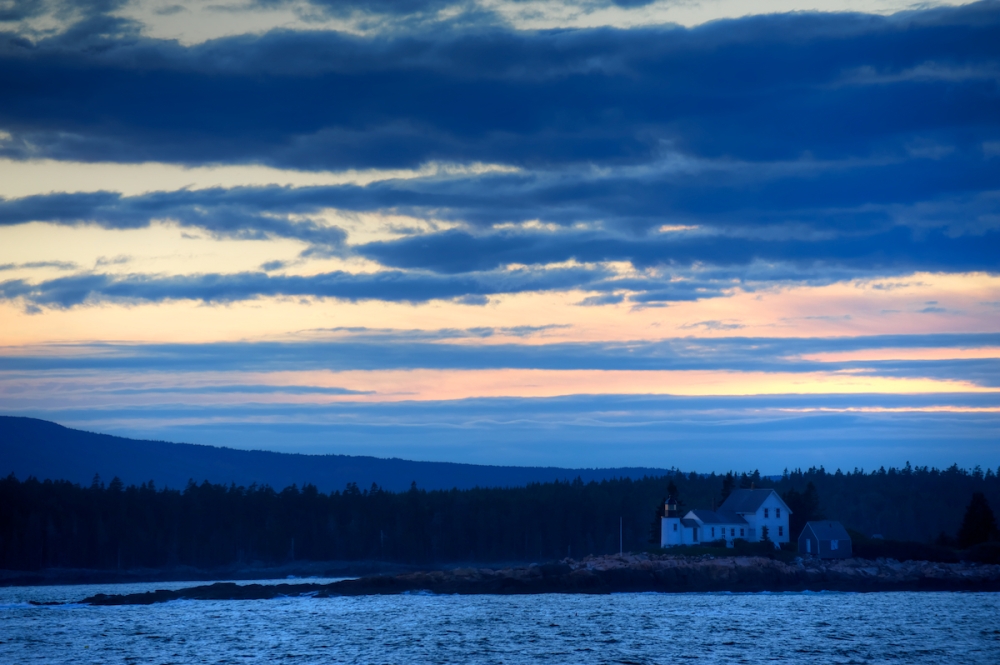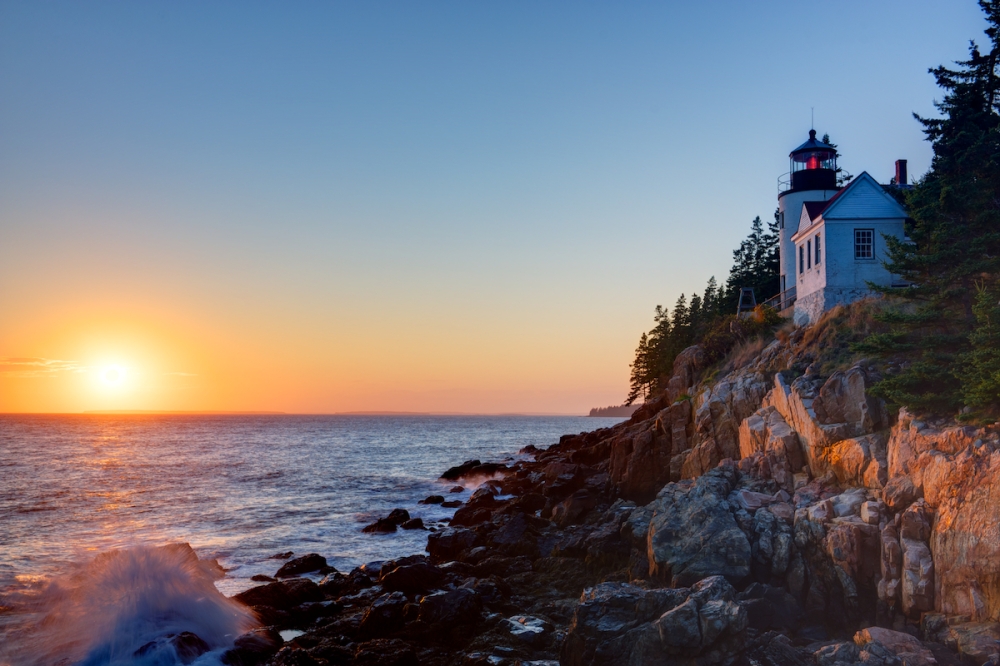When we visited California this past summer, I took a ton of beautiful images. Now that I’ve developed such a backlog of images to post I’ll have to blitz through a few of these. Here’s an image of a lighthouse that I’ve photographed before. I’d still love to spend a few weeks on the California coast so I’d have a shot at capturing a lighthouse like this one with epic sunset light bathing it and colorful skies overhead. But, that’s not often to be found in the summer season when we are usually in the area. So, here’s a still beautiful version of the Pigeon Point Light Station. In early summer the coastal fog usually descends on the region yielding this beautiful, evenly lit type of image. Enjoy.
Lighthouse
St. George Island Lighthouse and Full Moon
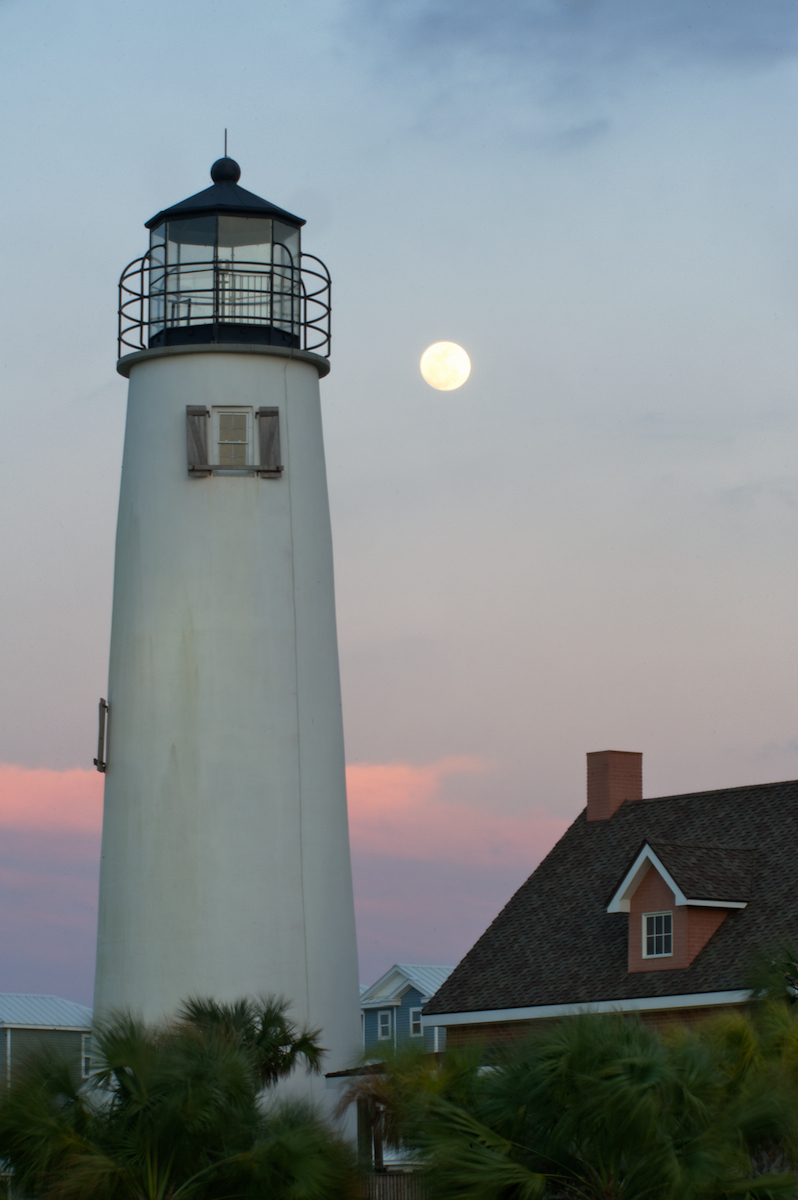
While we were at St. George Island for spring break, I noticed that the moon would be approaching its full phase during our visit. I marked it on my calendar so I would be on the lookout the two days before the actual full moon through the full moon itself. I’ve taken several shots when the moon is approaching full phase. I like that the moon rises before the sun sets, so you still have the last light of the day or dusk illuminating subjects while still capturing the moon in an image.
The idea that I had was to find a vantage point far enough away from the lighthouse to actually silhouette the lighthouse in the full moon. Unfortunately, St. George Island is about four miles offshore and the angle I needed to produce that shot would have meant renting a boat and taking the image from a moving boat. That wasn’t going to happen for three reasons: I didn’t want to rent a boat just to take the shot, the one second or so exposure that I would need to make the shot happen couldn’t be done from a moving boat, and I don’t have the 600mm or so lens that the shot really requires.
So, I abandoned the silhouette idea and moved on to just capturing the moon and lighthouse in the same frame. That’s what you see here. If you look closely, the moon is slightly overexposed and just a bit out of focus. That’s because even at f45 I still couldn’t get the moon and the lighthouse in focus without manually focusing on a point about 200 feet between the lighthouse and the moon. To be honest, I can hardly tell so it just isn’t a big deal. I probably should take a properly exposed moon shot that I took and put it into the scene with Photoshop. Maybe I will someday, but for now I like the image the way it is. I hope you do as well.
Portland Head Light on a Foggy Day
One of my primary objectives on the Maine trip was to capture an iconic image of Portland Head Light. We had flown into Portland and would fly out of there as well. As it turned out, the lighthouse was only twenty minutes away from the airport. So, I would have three shots at photographing the lighthouse. I thought that would surely be enough and I certainly would get good conditions on at least one of my visits. As it turned out, I needed to learn a thing or two about the weather in coastal Maine.
On landing we headed straight to Portland Head Light in Cape Elizabeth hoping to catch a break in the weather and to capture a decent image of the lighthouse. Even though the conditions were gloomy while landing, we still took the trip over. We had no luck although we did capture a good image of the lighthouse then. As it turned out, this image was the best one of the lighthouse on the entire trip.
We returned the next morning only to find even worse conditions. It was neat to hear the foghorn and bell, smell the salty air, and experience the Maine-like conditions. It just wasn’t the photograph I had envisioned. I left disappointed but hopeful because I knew that I would have another shot at the image at the end of our trip. Surely conditions would change by then.
And conditions did change. After a deluge the following day and evening, the weather turned clear, crisp, and beautiful. We had wonderful conditions for photographing Acadia and on our way back down the coast toward Portland. But, on our last day, the weather turned against us once again. The rain moved back in and fog settled along much of the coast. The good news was that this weather system was supposed to be short-lived. The bad news was that it wasn’t supposed to lift until a few hours before our plane took off.
So, in order to have one more shot at the jealously sought after iconic image of Portland Head Light, we headed there as the last stop of our trip. We had an hour or so to kill before we had to be at the airport. The weather forecast showed that we should now be experiencing clearing skies. However, this image shows what we actually experienced. The ceiling wasn’t quite as low as it had been at the beginning of the trip, but it still wasn’t the brilliant sunrise or sunset I had hoped for. It wasn’t even a partly cloudy sky to make for an interesting background to the shot. So, I took this image from the trail on the opposite side of the lighthouse from where the original image was taken. I like the way the ocean is bubbling and boiling below. But, alas, it wasn’t the image I had hoped for.
Having squeezed out as much time as we could and not be in jeopardy of missing our flight, we left Cape Elizabeth. We made our way back to the airport, returned our rental car, checked in, and headed for the gate. Have you been to the Portland airport before? It’s a really neat small airport with modern architecture and neat artwork hanging from the ceilings. It also has huge floor to ceiling windows that allow you to take in the surrounding views. And what did I see? Yes, the elusive blue skies were lifting from the coast and beautiful sunshine began to flood the airport. We had only missed ideal conditions by an hour! I was totally bummed and more than a bit frustrated. I wanted to head back out right then and take my shot. But, I couldn’t.
All things considered, it was a brilliant trip. Maine was everything I had hoped it would be. The conditions had been as good as I could have hoped for. I had captured some amazing images – and I had a perfect excuse to return.
Barn Door and Flag
The weather turned ugly the afternoon of the day we shot at Pemaquid Point Light. Our plan was to make our way back to Marshall Point Light which was sort of on our way home. The unusual thing about the Maine coast is that it takes a long time to get just about anywhere. The coast is a beautiful series of peninsulas that jut out into the Atlanta. Those peninsulas usually end in a rocky headland with a beautiful lighthouse perched somewhere on the edge.
As you can see from the map, the distance from Pemaquid Point to Marshall Point isn’t that great. But, by the time you drive all the way up one peninsula and down the next, the distance is probably four times greater than the direct water route. Because of this anomaly, we spent a week along the Maine coast and felt like we had driven the entire time. The irony is that we could have taken I-95 and driven from Portland to Bar Harbor in four hours or so. Of course, we would have missed all the beauty. It really is a different world just a few miles east of the interstate.
This picture was taken somewhere on the coast road between Pemaquid and Waldoboro. I didn’t have the GPS gizmo attached to my camera for part of the day and didn’t get the exact fix. By the way, we had a great lunch in Waldoboro. One of the best things about traveling is the need to try different food at different places. Moody’s Diner is one of those places. It’s been in the same location since the 1920s and looks it. The place has been added onto haphazardly yet the food is still delicious. It’s simple diner fare but done well. You definitely should stop in there if you are in the neighborhood.
There really isn’t anything super special about this shot. I just love the green grass contrasting with the deep red color of the barn. The weathered shingles and boards give the image some added interest. The flag is weathered and seems made to hang from the door of this old barn.
There really are millions of images that can be taken on the Maine coast. It’s a truly beautiful part of America that many people will never visit. That’s a pity, but a relief all at the same time. I know the coast is jammed with people during Maine’s short summer. But, the rest of the year is blessedly free of the mobs. Visit there sometime – but don’t tell your friends about it. It’s just our little secret.
Pemaquid Point Lighthouse and Reflection
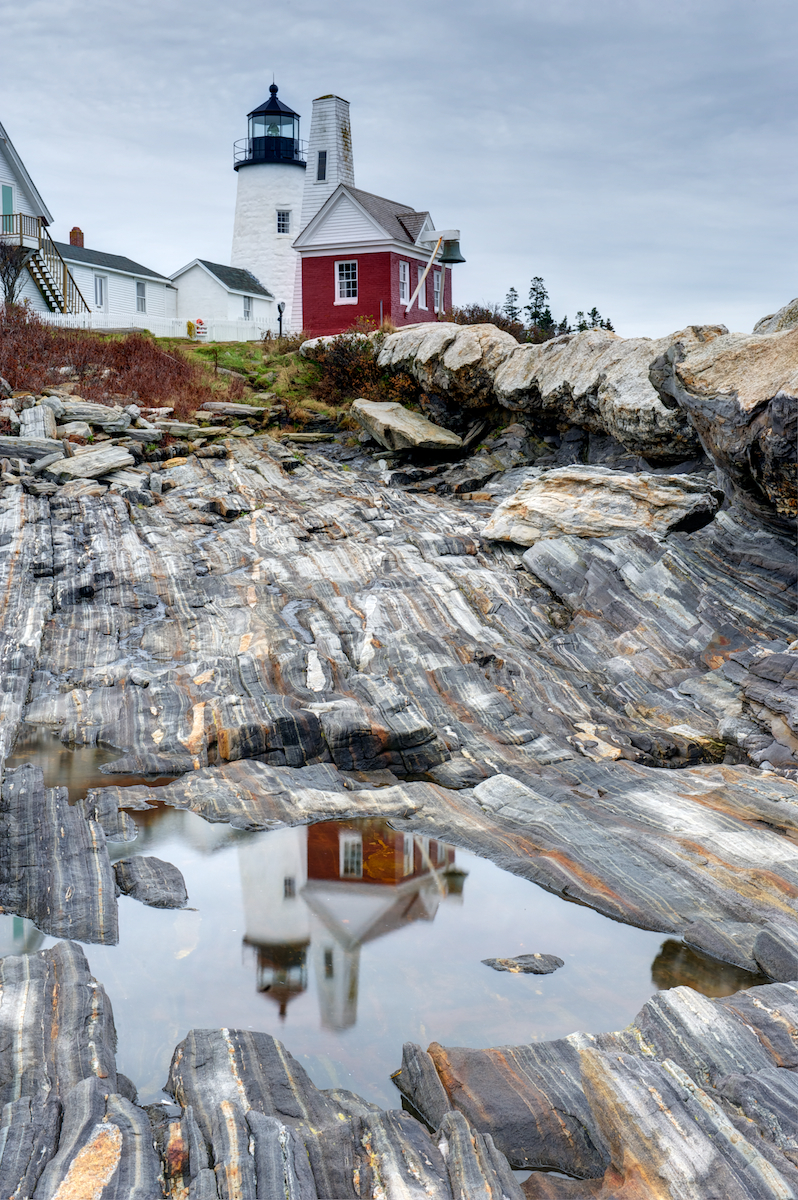
Pemaquid Point lighthouse, as reflected in a shallow tide pool, and the unique rock formation that stands between it and the ocean
Pemaquid Point Lighthouse is one of a string of many lighthouses that dot the Maine coast. Most, though, are not as scenic as Pemaquid Point.
There are a number of factors that make this lighthouse unique and visually appealing. The first and most obvious is its setting. Some lighthouses are placed into narrow openings on a rocky headland or are visible only from the sea. Pemaquid Point sits majestically on a rocky point and is visible from all angles.
The red outbuilding that sits alongside the lighthouse adds to the visual impact of the scene as well. The building is a bell house that was added to provide an audible warning in addition to the visual cue of the light itself. Given the fact that the lighthouse is located less than a hundred yards from the ocean, it’s hard to believe that its powerful light beam might not be a sufficient warning to passing ships. You can see the bell hanging from a white arm on the ocean facing side of the red bell building.
Perhaps the most unusual aspect of this scene is the rock formation that forms the foreground of the image. The rock ledges seen here extend all the way to the ocean and form beautiful leading lines toward the lighthouse. I’m no geologist, but from what I’ve read the rock ledges are primarily metamorphic with strands of igneous rock running in veins alongside the metamorphic. The igneous rock can be seen in the extreme right mid-ground while the other ledges are metamorphic.
The final unique visual element in this image is the reflection. After heavy rains or high tides, these pools appear in depressions in the rock. On calm days they make ideal tools to create reflections of the lighthouse and outbuildings. On this day I had to wait quite a bit while wind gusts passed through in order to eliminated ripples that would form in the pools.
I had hoped to capture this scene with a brilliant sunrise or sunset as the background. At the very least, I hoped to get a partly cloudy day with a mix of blue sky and interesting cloud formations. Unfortunately, on our way up the coast and back down we had leaden gray skies. Fortunately, on this day the rain held off until well after our visit allowing us to negotiate the rocks without slip sliding away (an homage to Paul Simon).
This is by no means a unique image. I’ve seen many different versions taken from this spot or another one close by on the rock ledge. However, it is one that I’m glad to have in my collection. There’s a reason that this lighthouse is visited so much. It’s scenic and deserves to be visited and photographed repeatedly.
Winter Harbor Lighthouse at Sunset
One of the primary reasons for our visit to the Schoodic Peninsula was the chance that we might see an epic sunset over Mt. Desert Island. Having been on top of Cadillac Mountain looking toward the peninsula at sunrise, it seemed like a different angle that might not have been captured often. So, as is often the case, I found myself scrambling toward a sunset location without really knowing where I wanted to end up. We had seen a lighthouse in the bay earlier in the day, so I had some inkling of an idea about putting the lighthouse in the foreground of an awesome sunset.
Unfortunately, we lingered too long in Corea capturing its pastoral beauty, further down the peninsula shooting crashing waves, and stopping periodically to take just “one more shot”. That’s usually the way it is when I am in some beautiful place that I have never been before. I never seem to leave enough time to shoot as much as I would like.
In any case, we were cruising down the highway watching the sunset becoming more promising by the minute. By the time we turned down the coast road, it was obvious that we would need to stop as soon as we found a decent foreground. Fortunately, the aforementioned lighthouse came into view just a couple of miles down the road. Once we found the right spot, we stopped quickly and set up the tripods. The good news was that a dynamite sunset was forming. The bad news was that it was mostly blocked by Cadillac Mountain and the truly bright colors were hovering near the horizon. We could tell that the sunset at Bass Head Light was fantastic. We were unfortunately a day early. That is where we had spent our sunset the night before and had only a slight bit of color in the sky.
So, I turned my attention to what I had available – the lighthouse. The lighthouse appears to be referred to as both the Winter Harbor Lighthouse and the Mark Island Lighthouse. Even though the truly gorgeous sky was twenty degrees or so to the south, there was still some color beginning to show near the lighthouse. I began to visualize a shot with the lighthouse on the horizon with a cherry red sky above. That never materialized. In fact, the sun set and the ambient light began to dim. But, as is often the case with sunsets, the longer I waited, the more color appeared in the sky. I decided to bracket some exposures and see if I could create a usable image of the lighthouse without totally blowing out the much brighter sky. Both of these images are a result of that process.
They are both shot at f/5.6 and varying speeds. I used my 70-200 2.8 with a 2x teleconverter which pushed my aperture to 5.6. I didn’t need that much depth of field for this shot since the lighthouse was probably a half mile away. I wish there had been enough reflected light to illuminate the lighthouse a bit more. I don’t like how dim it is in either image. I do like the composition and the sky above. My favorite of the two images is the first because of the pink, rosy sky and the slightly brighter white of the lighthouse. However, I prefer the composition of the second image even though the atmosphere rendered the clouds and the entire scene a bit too blue for my taste. I’d love to get some other opinions about which image you prefer.
Bass Harbor Head Light
One of the unique aspects of Maine is the variety and quantity of lighthouses that are found all along her coast. Although we saw plenty of lighthouses on the fall excursion to Maine, Bass Harbor Head Light is the most scenic lighthouse within the boundaries of Acadia National Park.
The problem with a pretty lighthouse is that just about everyone wants to look at it and take a picture of it. That problem was exacerbated by the fact that we were in the park during the peak fall color season and loads of other photographers wanted to take a shot of a lighthouse as well. We arrived about an hour and a half before sunset and there were already two dozen or so photographers present. To take this shot, you have to crawl out on the rocks near the surf line and find a decent spot to set up your tripod. In this case, that was difficult because the early arrivers (as if an hour and a half isn’t early enough!) had take the prime locations. I had to fiddle around quite a bit to shoot just over the heads of the other photographers and still end up with a foreground to my liking.
After getting set up, we basically stood our ground and waited for the light to get better. A few intrepid photographers tried to move to some unoccupied locations close to the water and ended up getting soaked by the rising tide and crashing waves. One stepped into a tide pool and soaked his trousers up to his thigh. A few people tried to tuck into spots that weren’t really big enough for another person and only ended up irritating those who had been there early. At one point someone counted over fifty of us clinging to the rocks like a pod of lobsters!
Finally, the sun moved close enough to the horizon to create some golden light. There weren’t nearly enough clouds in the sky so shooting into the sun created a huge latitude of exposures in the scene. I had to shoot seven images bracketed by one stop each in order to capture the highlights in the water and on the lighthouse along with the shadow detail in the rocks in the foreground. I blended the images together with Photomatix Pro’s Exposure Blending tool. I didn’t capture all the detail of the sun and the rocks are perilously close to being underexposed, but I like the image overall.
As luck would have it, we were a few miles away the next night, and a brilliant sunset ensued. I couldn’t help but wish that we had been at Bass Harbor Head Light on that afternoon. At least in my mind’s eye, I would have had an altogether different and better image to share. But, that didn’t happen. That is the kind of thought that keeps a photographer returning to the same scene over and over again.
Portland Head Light and Fog
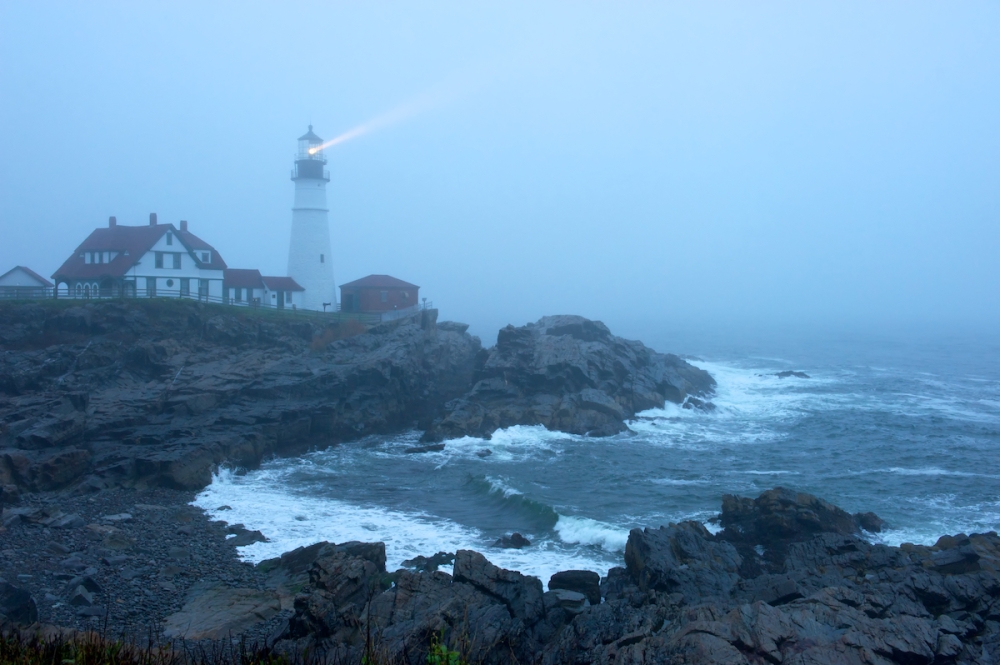
The Portland Head Light was shrouded in fog and mist allowing its lifesaving beam of light to be viewed.
Well, it’s been a busy fall. In fact, I don’t recall the last time that I posted. Fortunately, I’ve been busy with work, family, and some opportunities to capture some new images. Hopefully I will be able to post for quite a while with some new images from my fall travels.
When we were first married, Pamela and I managed to make it up to New England about every other fall. We enjoyed just knocking around the backroads, staying in some quaint inns, and generally going wherever looked good on that particular day. As kids arrived on the scene, that schedule began to be difficult to maintain. They have this thing called school and the authorities tend to frown on parents who just yank their kids out because the school schedule conflicts with the parent’s interests. Yes, we’ve done it from time to time, but needless to say, education trumps recreation the vast majority of the time.
Partly inspired by those trips to New England, I’ve begun to take a week or so each fall to travel to somewhere with beautiful fall color. Something about the way the landscape lights up with the vibrant colors of foliage makes fall my favorite season of the year. When I began to think about this year’s trip, the coast of Maine came filtering back through my memory. I recalled being in Acadia on Columbus Day weekend and being awed by the beauty of the place. So, the trip came to fruition. I flew in and out of Portland, Maine, and spent a week with a buddy just enjoying coastal Maine. The big star of the show was Acadia National Park, but there are loads of beautiful places all along the Maine coast.
In fact, one of the places on my list was this lighthouse. The Portland Head Light may be the most photographed lighthouse in Maine or even on the East Coast. It’s easy to get to, very photogenic, and classically built. In fact, it was authorized by George Washington and built during his term. I would have three chances to photograph the lighthouse – the evening we flew into Portland, the next morning, and on our way back into Portland. As it turned out, the weather was foggy and misty for all three occasions. We had beautiful weather in the middle part of our trip, but the days when we were in Portland were just miserable.
Now that I’ve whined and moaned about the weather, let me say that I really like this shot, anyway. Most pictures of lighthouses are made on bright, sunny days. But, you don’t need a lighthouse on a bright, sunny day. You need one on a day like this. It isn’t hard to imagine why fishermen, sailors, and other mariners are grateful for the light and bell of the Portland Head Light when you literally can’t see more than a few hundred yards out to sea. In this image, you can actually see the beam of the life-saving light. The waves in the foreground give you some sense of the rolling seas and waves that were building offshore. As I write these lines, I can still smell the salty air, hear the gulls circling overhead, hear the clang of buoys anchored offshore, and almost feel the mournful sound of the foghorn warning those at sea to stay away from this rocky point.
In some ways, this shot set the tone for the trip. We would experience Maine in all of her ruggedness. It was going to be a truly memorable and adventurous trip.

